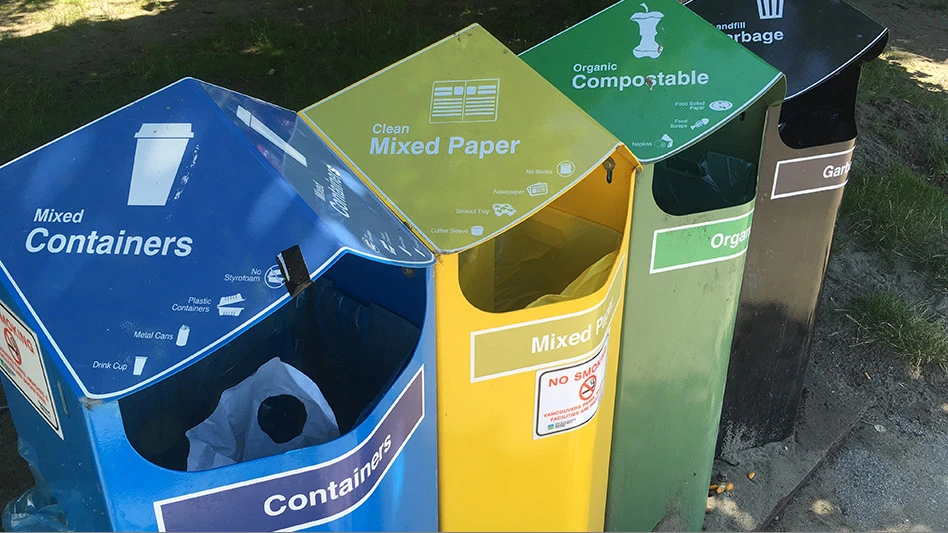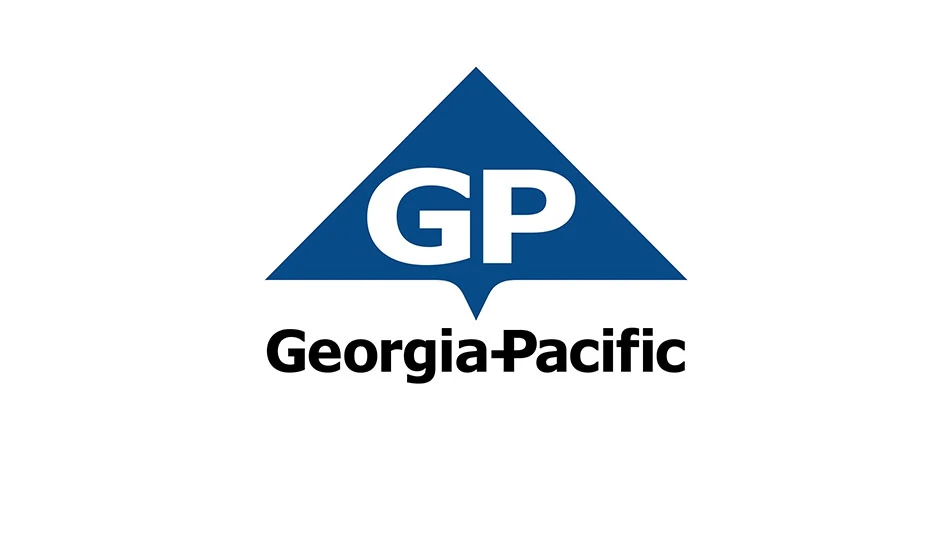The uses might be bite-sized, single serving or big gulps, but when considered as a whole, the packaging industry consumes a sizable quantity of raw and secondary commodities.
When one Fortune 500 beverage company, for example, begins favoring plastic over aluminum, entire global markets can be affected. And those markets – both global and domestic – are significant ones.
STAKES LARGE, SHIFTS SUDDEN
The can industry is just one of several food, beverage and household item container segments fighting for market share. According to the Can Manufacturers Institute (CMI), Washington, the U.S. can making industry consists of 132 companies operating 250 facilities with 32,000 employees. Those companies produced more than $12 billion worth of aluminum, steel and other cans in 1996, according to CMI.
Add to that employment and sales figures from the plastic, glass, paperboard and hybrid material container makers, and the resulting numbers reveal the impressive size of the packaging industry. In a land where per capita consumption outpaces every other nation, that which is sold is also packaged. And there is a new corollary to this statement: that which is packaged one way can always be packaged differently.
The soft drink industry provides a recognizable illustration of how packaging preferences can shift. Just two decades ago, bringing returnable glass soda bottles back to the grocery store was a ritual for many Americans. But now glass returnables are extinct in many metropolitan markets and "just a blip" on the breakdown of soft drink packaging, according to E. Gifford Stack, vice president of environmental affairs for the National Soft Drink Association (NSDA), Washington.
The glass industry suffered from the shift away from glass while the benefits of increased market share went to the aluminum and plastic industries (see chart on page 98).
PLASTIC GAINS ON MANY FRONTS
A scan of grocery and carry-out store shelves reveals what the numbers bear out: new uses are being found for plastic in virtually every product segment. Has plastic gained ground because it provides the best bottom-line container option for product manufacturers? Those within the plastic and retail products industries say that is part of the reason, but they also cite consumer preference factors for plastic’s success.
"I’ve seen companies that have made switches to plastic, and their primary objective was to fit in with consumer lifestyles," says Susan Dorn, a spokesperson for the American Plastics Council, Washington.
From the corporate viewpoint, companies can save on shipping costs when the total weight of packaging decreases dramatically per unit. A ratio of package weight to product weight, says Dorn, reveals a significant advantage for plastic containers with their average 34:1 product to container weight ratio. The next closest material is aluminum at 22:1 followed by paper at 7:1 and glass at 2:1, according to Dorn.
Within the soft drink segment, Stack says there are also consumer preference reasons for the success of plastic. "I think the resealability of the plastic bottle is becoming more popular," he remarks. "You can close it tightly and keep it from spilling while also maintaining the product’s integrity."
The 20 ounce size of PET bottles has also won favor with consumers, says Stack. "Twelve ounces is not enough for some consumers, and for others 20 ounces is preferable because they can get two 10-ounce servings from it."
Stack, who notes that his association does not favor one package type over another, says aluminum continues to please some consumers, as does glass despite its diminished market share. "Many prefer the aluminum can because that 12-ounce size is perfect for them, while glass has followers who perceive it as the material that best protects the taste of the beverage." And of course, says Stack, there are those who buy almost entirely based on price.
NEW COMPETITORS
Although plastic may be regarded by some as the new kid on the block who turned into a monolith, it is neither the newest material nor monolithic. Hybrid materials such as aseptic packaging – best known as single-serving juice boxes – are new and prominent enough to threaten some newly-gained plastic market share. Plastic itself consists of any number of chemical polymers, including some new ones seeking to push aside more established plastic types.
Earlier this decade, aseptic packaging was regarded as a material that could make significant inroads in the beverage packaging market. Aseptic packaging consists of paper, plastic and aluminum layers bonded together to form a flexible, single-serving package. Initially touted as a rising star in the juice packaging industry, it may have already plateaued at around 350 million units in that category.
But Marshall Cohen, president of the Aseptic Packaging Council, Arlington, Va., says the material is beginning to enter other markets. He lists the sports drink and institutional food service markets as areas where aseptic packaging is gaining ground.
While plastic may be treated as one material by some industry observers, the seven types of commonly-used plastic in the packaging industry compete among themselves for market share. The traditional plastic packaging powerhouses are HDPE (high density polyethylene) and PET (polyethylene terephthalate), both of which are used in the high-volume beverage container market. HDPE is also used in the hygiene and personal care segment, while sauces and condiments are increasingly packaged in PET bottles.
A newcomer known as PEN (polyethylene naphthalate) may also enter the scene soon and is being billed as a plastic type that could compete with glass in one industry segment where it has remained dominant: beer. Superior "barrier" qualities may help PEN provide the spoilage protection and flavor purity required in beer packaging.
While PEN is already used in industrial fluid and other non-food applications, it is awaiting authorization for use in food and beverage packaging (when blended with PET) by the Food and Drug Administration.
METALS, GLASS FIGHT BACK
Plastic has made the most market share gains in recent years, and glass, aluminum and steel industry participants have begun looking at ways to retain and regain markets.
"Steel is still the dominant material in food cans," says Bill Heenan, president of the Steel Recycling Institute, Pittsburgh.
In addition to canned vegetables, fruits, soups and juices, steel is also still commonly used for paint cans, 55-gallon drums and aerosol containers. While cost factors continue to work in steel’s favor in these segments, Heenan also cites the material’s stackability, toughness, and ability to provide a long shelf life for food items as other pluses.
With material weight a consideration for manufacturers, the steel industry has made strides to lighten steel cans. "The can today is, on average, 30 percent lighter than it was 15 years ago," says Heenan.
On the marketing front, the steel and canning industries undertake efforts to convince consumers that steel cans are an effective way to maintain the nutritional qualities of vegetables and fruits, and that they also provide a tamper-resistant container that protects foods from spoilage.
Aluminum is probably most closely associated with its use in beverage cans. Indeed, in a recent presentation Everaldo N. Santos, executive vice president – South America of Alcan Aluminum Ltd., Montreal, credited the beverage can as one of two reasons for the aluminum industry’s overall growth in the last two decades. "During the 1980s, aluminum cans conquered the U.S., and they began to take on the rest of the world in the 1990s," said Santos.
By 1989, 45.7 billion soft drinks in aluminum cans were sold in the U.S., compared to just 19.5 billion cans and bottles of all other materials. While the aluminum can’s growth in pure volume continued through the first half of this decade, PET bottles are now enjoying a faster growth rate. 1996 marked the first year in more than a decade that aluminum soft drink can volume actually declined.
As noted earlier, the glass packaging industry has had the most difficult time fending off plastic in the majority of its consumer markets. Though it has held on to its share in the beer and wine segments, the plastic industry’s gains have often been at the expense of glass.
One strategy the industry is using is to position glass as the container of choice for high-quality products. "Products where manufacturers really care about the quality and taste they present to their customers is where glass can be found," says Louis D. Andrews Jr., president of the Glass Packaging Institute, Washington.
He points to pasta sauces, salsas, juices, teas and a new line of Campbell’s soups as glass success stories. As with PET, contoured bottles have provided a boost to glass, including such efforts as a bowling pin-shaped Budweiser bottle and a flask-shaped bourbon bottle.
IMPACT ON RECYCLING
When American consumers begin buying more plastic and less aluminum, for example, the shift is felt by the recycling industry. The packaging brought home from stores dictates what goes into the recycling bin and ultimately what enters the material recovery facility (MRF).
The recycling infrastructure that has developed in the last two decades has led to some impressive recycling rates for traditional packaging materials. For 1996, the glass industry points to a 38 percent recycling rate for glass bottles and jars. The steel industry claims a 58 percent steel can recycling rate and 63.5 percent of aluminum beverage cans were recycled last year, according to CMI.
The widespread availability of curbside and drop-off recycling has helped those numbers rise to their current levels, but so has the existence of stable end markets for all three secondary commodities. The comparative lack of such stable markets is still the most troubling aspect of plastic container recycling. Sorting between the seven plastic types is another often cited hurdle.
The recycling of products made from PET reached as high as 28.6 percent in 1994, but has subsequently declined. The recycling rate of HDPE has been rising consistently this decade, but was still at just 14 percent in 1996.
Clearly, recyclers must hope that any further gains for plastic within the packaging industry will be followed by increased markets for resins made from used plastic containers.
The author is managing editor of Recycling Today.

Explore the November 1997 Issue
Check out more from this issue and find your next story to read.
Latest from Recycling Today
- Massive Chinese steelmaking rebound recorded in March
- LME looks into sustainable metal pricing
- OnePlanet Solar Recycling closes $7M seed financing round
- AMCS launches AMCS Platform Spring 2025 update
- Cyclic Materials to build rare earth recycling facility in Mesa, Arizona
- Ecobat’s Seculene product earns recognition for flame-retardant properties
- IWS’ newest MRF is part of its broader strategy to modernize waste management infrastructure
- PCA reports profitable Q1





